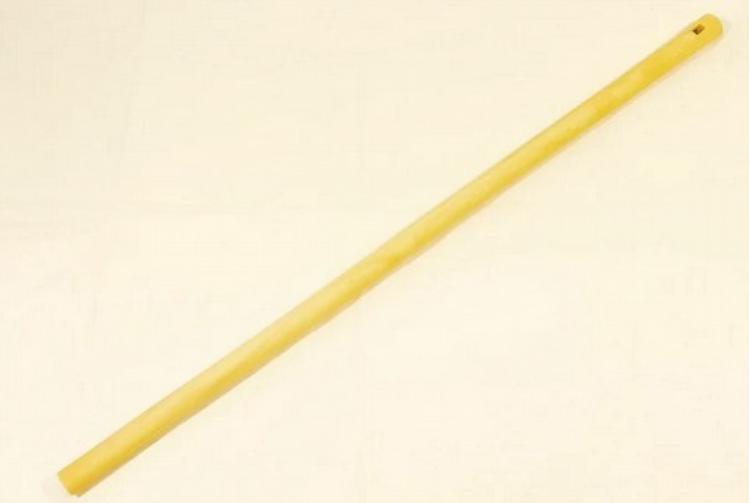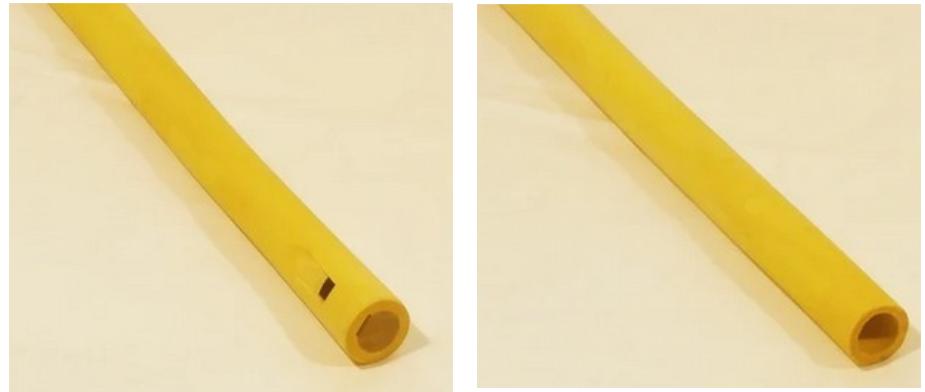by Howard Fosdick © FolkFluteWorld.com.
The overtone flute is the simpliest flute you can imagine. It's nothing but a long, hollow tube. It has no fingering holes. It may have either a plain blow hole like a transverse flute, or a built-in fipple, like a recorder.
You play the overtone flute by blowing into it at different breath pressures. The harder you blow, the higher the pitch. The full set of notes the flute can play is determined by the length and width of the instrument.
The overtone flute is the ancestor to all the tube-based flutes we play today. It's still an important part of historical culture in many eastern European nations, Russia, and Scandinavia. It's fun to play because it's based on such a different principle than flutes that rely primarily on fingering to produce notes. It also gives you an entirely different set of sounds than other kinds of flutes.
This is a review of the overtone flute I purchased from Hungarian Folk Music. For complete background on the overtone flute, its history and how it works, please see my comprehensive article, "All About the Overtone Flute".
Finding a Flute
Depending where you live, you may well have to order your overtone flute from another country. The tradition of making them survives only in certain regions.
I ordered my flute from a company called Hungarian Folk Music. Usually seen as "Hungarianfolkmusic" online, the Budapest-based company sells through both Ebay and Etsy. The price you'll pay includes shipping from Hungary to your home country. Delivery times are 4 to 7 days if you're in the EU, and 9 to 15 days if you're in the US. Flutes are securely shipped in a long, hardy cardboard tube.
Hungarian Folk Music sell a wide variety of keyless folk flutes. These include shepherd's flutes, renaissance flutes, tabor pipes, drone flutes, kavals, and more. Flutes are made in a variety of woods. They typically use elder for overtone flutes.
Here's how the company describes this flute:
"Tilinkó (overtone flute) is a special folk flute form Carpathian basin. It used in Moldavian, Romanian, Hungarian and Slovakian folk music. There are no holes, it plays the overtone system and if you cover the end you get extra sounds.
The softwoods - like elder - are very good raw material of overtone flutes. The structure of the material "vibrates" well, making it easy to switch between octaves. In other words, you will easily find the harmonics, scale and desired melodies."
My Overtone Flute
Hungarian Folk Music offers flutes in a variety of keys. The key determines the length of the instrument. This chart shows common keys and the notes playable in each.

I selected the flute in D. Here's what it looks like:

Hungarian Folk Music Overtone Flute (Courtesy Hungarian Folk Music)
As you can see, the flute has a built-in fipple. This makes it easier to get started with than transverse overtone flutes that have simple, unadorned blow holes. Here's a close-up of the fipple and the other end of the flute:

Hungarian Folk Music Overtone Flute (Courtesy Hungarian Folk Music)
Playing It
Learning to play this instrument is a lot of fun. You may be used to overblowing instruments to achieve an upper octave. This instrument has no fingering holes at all, so it relies solely on breath pressure to determine the notes you play.
There are few teachers or sheet music. Though you can find a few Youtube lessons. The emphasis is on improvisation.
I found it easy to get started -- though difficult to attain proficiency. To start, learn to play the different harmonics and memorize the breath pressure required for each note. Pay attention, too, to the approach or attack appropriate to each tone. This varies by pitch.
Then expand into the notes you can play by covering the end of the flute with your finger. You can use either your index finger or long middle finger to cover the flute's end, depending on how you cradle it.
Eventually, you'll develop a memory for the breath pressure and approach that enables you to quickly sound any note. Now you're ready to invent tunes.
Songs are usually improvised. So if you enjoy improvising, the overtone flute might be the perfect instrument for you. It's well suited given that its notes are natural harmonics.
On the other hand, if you favor the formality of sheet music or prefer direction, you might not take to the instrument as readily.
Once you acquire some skill, you'll find this simple flute capable of a wide range of musical expression. For example, you can trill either by rapid tongue movement, or by quickly waving your finger over the end of the tube. Create fades and slides by varying breath pressure, or by carefully moving your finger over the pipe end. Pop up notes in the natural scale by attacking with your breath. Drop down the scale by letting your breath blow out. Delicate vibrato enhances long notes. Exaggerated vibrato creates its own special effect.
My Opinion
If you want to buy an overtone flute, I can recommend Hungarian Folk Music. The flute they sent me in a timely fashion was well made. Customers give them very high marks as a seller on Etsy and Ebay. I consider them a good source of hard-to-find folk flutes and plan to buy other flutes from them in future.
***** SUMMARY *****
Instrument: Overtone FluteCompany: Hungarian Folk Music at Ebay and Etsy
Tuning: Keys of B, Bb, C, D, E, F, G
Range: Up to about 8 notes
Measurements: Length varies by pitch, 16.5" to 27"
Wood: Elder, other choices are possible
Cost: Varies, usually about $50 or $60 USD